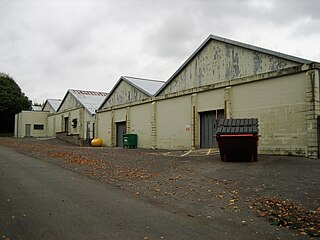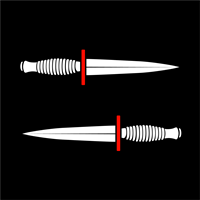The Rifles is an infantry regiment of the British Army. Formed in 2007, it consists of four Regular battalions and three Reserve battalions. Each Regular battalion of The Rifles was formerly an individual battalion of one of the two large regiments of the Light Division. Since formation, the regiment has been involved in combat operations in the later stages of the Iraq War and in the War in Afghanistan.

Larkhill is a garrison town in the civil parish of Durrington, Wiltshire, England. It lies about 1+3⁄4 miles (2.8 km) west of the centre of Durrington village and 1+1⁄2 mi (2.4 km) north of the prehistoric monument of Stonehenge. It is about 10 mi (16 km) north of Salisbury.

The 1st Armoured Infantry Brigade was an infantry brigade of the British Army with a long history including service during both the First and the Second World Wars. It was based at Tidworth Camp. Previously, it has been designated 1st (Guards) Brigade, 1st Infantry Brigade, 1st Mechanised Brigade, and under the initial Army 2020 reforms assumed the title of 1st Armoured Infantry Brigade. Under the Future Soldier programme, the brigade merged with the 1st Artillery Brigade to form the 1st Deep Recce Strike Brigade Combat Team.

4th Light Brigade Combat Team, previously known as 4th Infantry Brigade and Headquarters North East, and before that as 4th Mechanized Brigade and before that 4th Armoured Brigade is a brigade formation of the British Army, currently based in Catterick, North Yorkshire as part of 1st Division. The brigade, now known as the 'Black Rats', was formed in 1939 and fought in the Second World War in the Western Desert Campaign in North Africa. The Black Rats were subsequently involved in the invasion of Sicily and fighting in Italy before taking part in the Battle of Normandy and the advance through Belgium, Holland and into Germany.

The 20th Armoured Brigade Combat Team, previously the 20th Armoured Infantry Brigade, is an armoured infantry brigade formation of the British Army, currently headquartered at Wing Barracks, Bulford, Wiltshire, as part of the 3rd Division.

The 11th Security Force Assistance Brigade is a brigade of the British Army which is intended to train and assist foreign forces. In 2021, under the Future Army changes, the brigade was redesignated, formerly being the 11th Infantry Brigade & HQ South East. Prior to the Army 2020 changes in 2013, the brigade was temporarily activated for deployment to Afghanistan. Originally formed in the Second Boer War, the brigade was engaged during both World Wars.

The 12th Armoured Brigade Combat Team, formerly the 12th Armoured Infantry Brigade, is a regular brigade of the British Army which has been in almost continuous existence since 1899 and now forms part of 3rd Division.

The 11th Signal and West Midlands Brigade is a signal formation of the British Army's 3rd UK Division. Its headquarters is located at Venning Barracks, in Donnington in Shropshire.
In September 1939, the British Army was in process of expanding their anti-aircraft and mobile assets. Among these new changes was the formation of Anti-Aircraft Command which was formed on 1 April 1939, and the 1st Armoured Division formed in 1937. The list below will include the British Army units, colonial units, and those units which were in the process of formation.

1st Intelligence, Surveillance and Reconnaissance Brigade of the British Army was created as part of the Army 2020 reform, to command military intelligence, ISTAR, and electronic warfare units.
The 4th Military Intelligence Battalion is a military intelligence unit of the British Army's Intelligence Corps, which provides close intelligence support to the headquarters for the only warfighting division in the army.

Tidworth Camp is a military installation at Tidworth in Wiltshire, England. It forms part of the Tidworth, Netheravon and Bulford (TidNBul) Garrison.

The 1st Military Police Brigade is a policing formation of the British Army, which is the only one-star command of the Royal Military Police. The brigade was formed in 2014 and is commanded by a brigader, but is due to be re-structured and reduced to a colonel's command.

The structure of the British Army is being reorganised to the Future Soldier structure. The Army is commanded by the Chief of the General Staff (CGS), with Army Headquarters which is located in Andover, Hampshire. Subordinate to that post, there is a Commander Field Army, and a personnel and UK operations command, Home Command.
3rd (UK) Division Signal Regiment is a regiment of the Royal Corps of Signals within the British Army. The regiment is based at Bulford.

The Army Special Operations Brigade, previously called the Specialised Infantry Group, is a formation of the British Army, initially created as a result of the Army 2020 Refine reorganisation, intended to train foreign forces. Its name and role was adapted after the Defence in a Competitive Age reforms, to a unit that not only trains partner nations, but also fights alongside them in "complex high-threat environments".
The 7th Battalion, The Rifles is an Army Reserve battalion of the British Army originally formed from elements of the Royal Rifle Volunteers, and Royal Green Jacket badged Sub-Units of The London Regiment following the Future Army Structure programme, and remains an integral part of the regiment.
The 1st Deep Reconnaissance Strike Brigade Combat Team is a formation of the British Army, currently headquartered in Delhi Barracks, Tidworth Camp, Wiltshire, as part of the 3rd Division.















